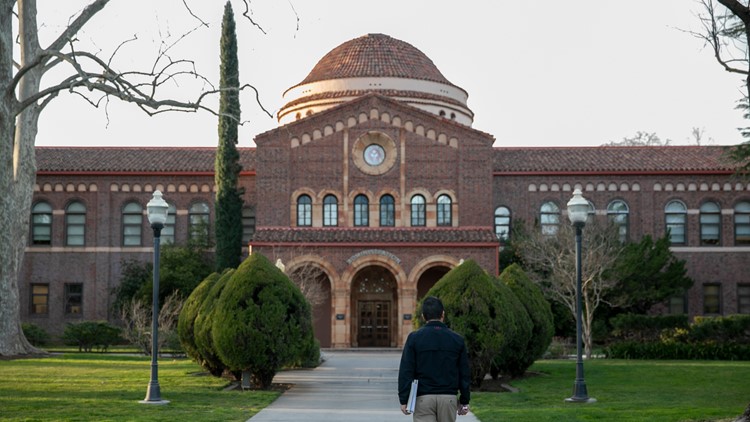CALIFORNIA, USA — This story was originally published by CalMatters.
Four California public universities could have received $47 million more in coronavirus aid if they sought funds from a different federal agency, a recent state audit found. As a result, some students may have missed out on support services and equipment during what has been an unprecedented disruption in schooling worldwide.
California colleges could apply to two pots of money — one supplied by the Federal Emergency Management Agency (FEMA) and the other by the U.S. Department of Education, called the Higher Education Emergency Relief Fund (HEERF). Of six University of California and Cal State University campuses audited, four used Department of Education funding for expenses where they should have asked FEMA for reimbursement, the audit said.
The audit recommended that Chico State, Cal State Long Beach, UC Merced, and UC San Diego apply to FEMA for reimbursement of about $7.5 million in past expenses and $39.7 million in planned expenses so they can use that money to support students.
The other two universities in the audit – Sonoma State and UC Riverside — had used and sought reimbursement appropriately, according to the audit. In total, the six universities received $822 million in HEERF funding.
FEMA could potentially reimburse campuses for expenses including coronavirus testing, vaccines and temporary medical tents. The U.S. Department of Education provided emergency funding to pay for those expenses, too, but that money could also be used for other pandemic-related costs such as technology services.
Though campus officials said FEMA reimbursement is a more difficult process, education advocates said that was not a good enough reason to give up millions.
“Students were having trouble meeting their basic needs,” said Yvonne Muñoz, a higher education policy analyst for the nonprofit advocacy group Education Trust West. “The emergency funding really should have been distributed with an urgency that recognizes that.”
The potential $47 million could have been used to directly support students, Muñoz said. Education Trust and the Global Strategy Group polled 1,010 students about their experiences during the pandemic and found that more students struggled with paying for necessities including rent, food and tuition during the pandemic, and a third of survey respondents frequently skipped meals because they couldn’t afford them, the poll found.
“Students were having trouble meeting their basic needs. The emergency funding really should have been distributed with an urgency that recognizes that.”
- YVONNE MUÑOZ, HIGHER EDUCATION POLICY ANALYST AT EDUCATION TRUST WEST
Getting the money back
Chico State officials said seeking reimbursement from FEMA isn’t so simple. About three years ago, they asked FEMA for reimbursement for costs associated with the deadly and destructive 2018 Camp Fire, and their claims were fully settled only recently, said Stacie Corona, Chico State’s associate vice president of financial services. Corona said it took almost three years to close out their FEMA claim for the Camp Fire.
“It’s quite a process, it’s a lot of back and forth,” Corona said.
Still, they’ve asked FEMA to reimburse $367,409 for pandemic-related expenses, and the campus hasn’t yet been paid, she said. The costs covered by the claims include PPE, cleaning supplies and sanitation stations, Corona said. The university has also filed a claim with FEMA for the additional $164,00 that the audit said it should reallocate from their HEERF spending, she said.
An official at UC San Diego — which lost out on the most with $4.3 million in spent dollars and $36.3 million in planned spending that FEMA could reimburse — also “indicated that FEMA’s claims process puts a large administrative burden on campuses to gather all of the required documents, such as invoices and receipts associated with each expense,” according to the audit.
“We agree with the recommendations outlined in the audit and are working on the recommended improvements to strengthen our use of federal aid funds, maximize the benefit of those funds to the University community, and ensure compliance with the changing landscape of federal rules and requirements governing the distribution of this aid,“ a spokesperson for UC San Diego said in a statement.
During a normal year, FEMA typically took about three to six months to process and approve applications for funds. During the pandemic, though, it could take about six to 12 months, according to the audit. Though campuses would have to wait for the money, the audit urged officials to apply anyway.
“Regardless of the amount of time it takes FEMA to process these claims, the millions of dollars the campuses could receive should outweigh their reluctance to engage in this process,” the audit said.
The audit explained where four schools went wrong with their federal aid, and where two schools — Sonoma State and UC Riverside — made better decisions.
Cal State Long Beach spent $2.836 million from the Department of Education on expenses including a temporary medical tent, coronavirus testing and vaccines, when it could have asked FEMA to reimburse those costs, the audit said. UC Merced spent $113,000 on FEMA-refundable items as well.
By comparison, the audit noted Sonoma State and UC Riverside made sure to use Department of Education funding for items that couldn’t be reimbursed by FEMA — such as purchasing technology for students.
“Regardless of the amount of time it takes FEMA to process these claims, the millions of dollars the campuses could receive should outweigh their reluctance to engage in this process."
- CALIFORNIA STATE AUDITOR
What’s next?
The audit found the UC Office of the President and the Cal State Chancellor’s Office should have given more guidance to schools on how to disperse the federal funding to avoid any mistakes.
Universities distributed the grant money to their students differently. So students at some colleges received grants while students at other colleges didn’t, even if they were in similar financial situations.
For example, UC San Diego gave out the same amount of automatic grants to nearly all students, while UC Riverside distributed grants based on students’ expected family contribution in their financial aid documents.
These grants also varied by school. For example: a student who had an expected family contribution of $1 to $2,000 would receive a grant of $900 at Chico State, $1,300 at Sonoma State and $500 at CSU Long Beach.
Students at Cal State Long Beach, Chico State and Sonoma State could also apply for additional grants if they believed their college underestimated their pandemic-related expenses. Cal State Long Beach, however, only awarded extra grants to students if they applied for money because of the change to virtual instruction.
Nathen Ortiz, a student intern at Let’s Go To College CA and a senior at Cal State Fullerton, said he received a grant from his university that was deposited into his bank account. He said he would have liked to see more engagement with students, to provide students more information about the grants, including where the funding came from and how students could apply for more aid.
“Every university should be including a lot more students in terms of budgeting and how certain money should be allocated across different campus departments,” Ortiz said.
The fact that grants were dispersed differently across universities shows how “higher education is very inequitable,” he added.
The differences in grant funding caused confusion among students. When students compared how much federal aid they received with friends at their own university and other universities, they didn’t know why other people qualified for more funding and others for less, according to Marcos Montes, the program manager of Let’s Go to College CA, a program created to support students through the coronavirus pandemic.
“It’s important for campuses to find the balance between ensuring that they are catering to the needs of their specific student populations, but also that there is uniformity in how they spend and use those dollars,” Montes said.
As the audit recommended, the UCOP will require each campus to write a report on their pandemic-related expenses from January 2020 to Dec. 31, 2021 to ensure all eligible items are submitted to FEMA for reimbursement, according to university spokesperson Joanna McWilliams. The university hasn’t set a deadline yet for the reports, she said.
The Cal State Chancellor’s Office, however, will not require campuses to submit a report but will assist campuses who want to apply to FEMA for reimbursement, spokesperson Mike Uhlenkamp said.
“In addition to adding an additional level of bureaucracy to the process, there is also no guarantee that FEMA will approve those claims, much less in a timely manner,” Uhlenkamp said via email. He added that the average wait time for reimbursement claims from FEMA to campuses is 279 days.
CALmatters.org is a nonprofit, nonpartisan media venture explaining California policies and politics.



